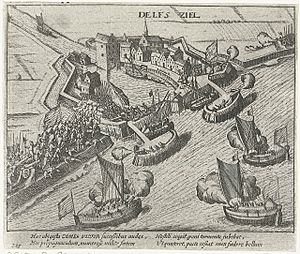Capture of Delfzijl facts for kids
Quick facts for kids Capture of Delfzijl |
|||||||
|---|---|---|---|---|---|---|---|
| Part of the Eighty Years' War & the Anglo–Spanish War | |||||||
 Siege of Delfzijl July 1591; from the workshop of Frans Hogenberg |
|||||||
|
|||||||
| Belligerents | |||||||
| Commanders and leaders | |||||||
| Strength | |||||||
| 9,000 | 300 10 guns |
||||||
| Casualties and losses | |||||||
| Low | All surrendered | ||||||
The Capture of Delfzijl was an important event during two big wars: the Eighty Years' War and the Anglo–Spanish War. It happened in 1591. An army from the Dutch Republic and England, led by Maurice of Orange, attacked the city of Delfzijl. The attack started on June 26 and ended on July 2, 1591, when the Spanish soldiers defending the city gave up.
Contents
Why Delfzijl Was Important
Setting the Scene for Battle
In early 1591, Maurice of Orange began a plan to push the Spanish army out of the Netherlands. The States General of the Netherlands wanted to capture the city of Nijmegen. But first, other towns like Zutphen and Deventer needed to be taken. This strategy was meant to trick the Spanish. It made them think the main target was somewhere else.
First, Zutphen was captured by Dutch troops under Maurice. Then, Deventer was taken by English troops led by Francis Vere. The next goal was Groningen in the North. Two years before, William Louis, Count of Nassau-Dillenburg, had captured a small fort called a sconce at Zoutkamp. This made people think about attacking Groningen. But Maurice decided against it because Groningen was too strong. Also, the powerful Duke of Parma and his army were getting close.
The Attack on Delfzijl
A Quick Victory
Instead of Groningen, Maurice decided to go straight to Delfzijl. This town and its fortress were located on the shores of the Dollart. The Dollart is a large inlet of water that separates the province of Groningen from a German area called Emden. Emden was a key supply base for the Spanish.
On June 26, 1591, the combined Dutch and English army arrived at Delfzijl. They had brought their heavy cannons by using 150 boats along the waterways. The Spanish soldiers defending Delfzijl were only 300 strong and had ten cannons. Both sides knew the fight would not last long.
The Anglo-Dutch army set up their positions around the town. Once all the cannons were ready, they began firing. After a few days of heavy bombing, the Spanish soldiers realized no help was coming. They decided they had had enough. On July 2, they started talking about surrendering. Maurice agreed to their terms. The Spanish soldiers gave up and were allowed to leave for Groningen. However, any soldiers who had been disloyal or had switched sides were not allowed to leave.
What Happened Next
After the Surrender
Francisco Verdugo, who was the Spanish governor in the province of Groningen, was very angry when the surrendered soldiers arrived. He ordered that their captains be punished. He also made the soldiers feel ashamed. Twelve soldiers were chosen by drawing lots (like picking names from a hat) to be put in prison. Five of these twelve were later punished even more severely.
After taking Delfzijl, Maurice made the town's defenses stronger. He followed the original plans made by Johan van den Kornput. He also left a small group of Dutch and English soldiers to guard the town. In early 1594, this small group successfully fought off a Spanish attack led by Francisco Verdugo.
After securing Delfzijl, Maurice and his army marched towards Hulst and Nijmegen. However, they had to stop at Knodsenburg. There, they fought and defeated the Duke of Parma, who was trying to attack that place.

